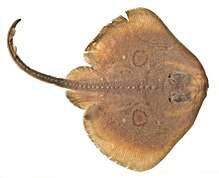Raja stellulata
| Raja stellulata | |
|---|---|
 | |
 | |
| Beringraja stellulata, conventional and X-ray images | |
| Scientific classification | |
| Kingdom: | Animalia |
| Phylum: | Chordata |
| Class: | Chondrichthyes |
| Subclass: | Elasmobranchii |
| Order: | Rajiformes |
| Family: | Rajidae |
| Genus: | Beringraja |
| Species: | B. stellulata |
| Binomial name | |
| Beringraja stellulata (D. S. Jordan & C. H. Gilbert, 1880) | |
| Synonyms | |
| |
The Pacific starry skate, rock skate, prickly skate or starry skate (Beringraja stellulata) is a species of cartilaginous fish in the family Rajidae. It is found on rocky bottoms at 18–982 m depths (typically 70–150 m) in the Northeast and Eastern Central Pacific, from Coronado Bank in northern Baja California in Mexico to Barkley Sound in British Columbia, Canada. Females reach a maximum total length of 76.1 cm and a maximum age of 15 years, while males can be up to 71.7 cm long and live up to 14 years; the total length at birth is 15.5–22.5 cm. This skate prefers cold water with a temperature of 4.1–11.6 °C (average 8.9 °C).[1]
Description
Beringraja stellulata, have a row of strong spines along their mid-dorsal line. They also have large spines on their shoulder girdle. A row of small spines is located on the inner edge of the orbit of the Beringraja stellulata. Clusters of moderate spines are also located along the edge of the pectoral fin. Starry skate males also have a large spine. The dorsal and caudal fins are small. The anal fin is absent in starry skates. The pectoral fins are broad and attached to the snout and incorporated with the body. Pelvic fins are large and deeply notched. Starry skates have a horizontal fleshy ridge from either side of the ventral surface to the tail, this is more prominent in the posterior. Beringraja stellulata are a grayish brown color with numerous dark spots of various sizes scattered on the body with a weakly marked eye spots that is often present at the base of the pectoral fins.[2]
Habitat
Starry skates are known to live on hard substrate near rocky reefs.[3] They can also be found on soft sediment, however they are more commonly found on rocky surfaces.[3] They are found at depths of 18–982 m.[3] Within these depths, they are most commonly found in depths of 70-150m.[3]
Reproduction and life cycle
The starry skate is oviparous.[3] They have a generation length of 8–12 years.[3] The egg cases of starry skates are striated and have long, robust horns.[3] Beringraja stellulata can reproduce year round and do not have a distinct cycle.[3] Their size at birth is 15.5-22.5 cm total length.[3] The young tend to follow large objects, which may be their mother.[2] The length at first maturity in females is 47.4 cm and 9 years of age. At 100% maturity, females reach the length of 69.2 cm and are 15 years old. The length at first maturity for males is 46.0 cm and 6 years old. Males are 65.8 cm and 13 years old when they reach 100% maturity.[3]
Distribution
Beringraja Stellulata can be found from the Bering Sea to Northern Baja California.[2] Some believe that the Berring Sea population may be a different species.[3] In this case, the Northern most location of the Beringraja stellulata would be the Karkley sound in British Columbia.[3]
Etymology
The genus name, Beringraja, is Latin for sting ray. The species name, stellulata, is derived from the Latin word stellular, meaning small star.[2]
References
- 1 2 Bigman, J.S., Ebert, D.A., Robinson, H.J. & Cailliet, G.M. (2016). Raja stellulata. The IUCN Red List of Threatened Species doi:10.2305/IUCN.UK.2016-2.RLTS.T161629A80677268.en
- 1 2 3 4 Froese, Rainer. "Raja stellulata". Fish base. Retrieved 28 April 2017.
- 1 2 3 4 5 6 7 8 9 10 11 12 "Raja stellulata (Pacific Starry Skate, Prickly Skate, Rock Skate, Starry Skate)". www.iucnredlist.org. Retrieved 2017-05-03.
| Wikimedia Commons has media related to Raja stellulata. |
